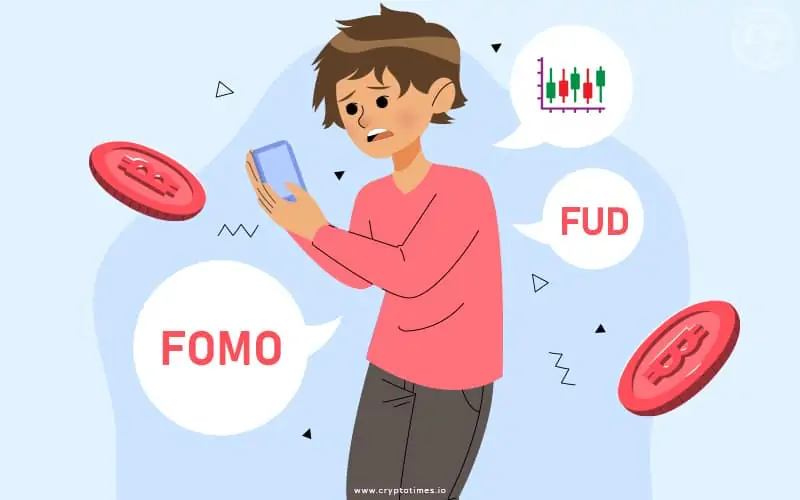The rollercoaster ride of the cryptocurrency is enough to give any investor whiplash. Market volatility and the sudden plunge leave traders to question their decisions.
These extreme swings between euphoria and despair are often driven by market fundamentals and psychological factors like FOMO and FUD. Therefore, understanding how these concepts can influence investors to take investment risks is crucial to avoiding market traps.
This article will explore the crypto market, the interplay between FOMO and FUD, practical tips for navigating the crypto market, and possible cases.
Let us dive in.
Understanding FOMO (Fear Of Mission Out)
FOMO is a popular slang in the cryptocurrency world. A world that has been associated with irrational and unsubstantiated trading decisions.
The concept refers to the pressure investors face, pushing them to make split decisions so as to take advantage of potential gains from rising asset prices or exciting market trends.
In crypto market metrics, FOMO often grips traders when a coin experiences price rallies. The fear of not being part of a major upside move can override logic and fuel greed. Investors buy in at any price, worrying that they will miss out on quick profits as prices continue to rise.
While crypto traders know pieces are volatile and can be reversed in a snap, FOMO triggers hasty “buy the hype” decisions.
In some cases, traders are reluctant to take profits on volatile assets. They try timing market tops perfectly rather than locking in returns. However, recognizing FOMO and focusing on long-term investment principles over short-term excitement might save you some money.
Now let us talk about its cousin.
Grasping FUD (Fear, Uncertainty and Doubt)
FUD refers to a feeling of fear, uncertainty, and doubt that can overwhelm investors and cause them to feel negative sentiments. In the crypto market, FUD often causes traders to sell assets or exit the position irrationally due to anxiety or panic.
However, this term is often used to describe the spread of negative or misleading information about a certain cryptocurrency or the crypto market in general.
FUD is contagious. The quick drop in pricing raises concerns that losses could worsen. As uncertainty kicks in and the future becomes bleak at that point, crypto’s viability is being questioned. When these emotions combine, they cause panic and impulsive sell-offs.
Investors or traders who have been captured by FUD find it difficult to differentiate facts from emotions. Logic, probabilities, and risk management are abandoned in favor of emotional fight or flight reactions. Decisions are dominated by irrational despair.
The Interplay Between FOMO and FUD
FOMO and FUD are opposing emotional forces that can heavily influence crypto investment decisions. Their tug-of-war dynamic helps explain the extreme boom and bust cycles in cryptocurrencies.
FOMO feeds on greed. It makes people willing to pay any price to join the action. They chase fast gains instead of focusing on what an asset is truly worth.
But crypto markets move wildly up and down. Super-fast rises eventually go too far. Prices get stretched and start falling.
Now fear, uncertainty, and doubt kick in-known as FUD. Investors worry the recent gains will completely disappear. Minor drops feel like crashes.
Practical Tips For Navigating Crypto Investment Psychology
To avoid making mistakes, it’s important to recognize FOMO and FUD when they happen. There are practical ways to keep a cool head and stick to smart investing habits even amid the crypto rollercoaster.
- Recognize emotional triggers like FOMO and FUD. Learn to spot when greed or fear are taking over your decision-making. This self-awareness helps you pause and think rationally.
- Lean on your pre-set investment strategy and process. Having a plan for entries, exits, and risk management is key to avoiding emotional reactions. Stick with what you decided when you had a calm mindset.
- Look beyond short-term price swings. Crypto is volatile, so expect lots of ups and downs. Focus on long-term potential based on fundamentals instead of daily volatility.
- Dollar-cost average to smooth out risk. Invest in set amounts at regular intervals, no matter the price. This helps avoid investing everything at peaks or market bottoms.
- Manage risk smartly. Use stop-losses and profit-taking to protect from downward drops or lock in gains from surges. Don’t let profits turn into losses or gains get given back.
Now, with the few tips highlighted, if diligently followed, you are likely to make good market decisions. However, Visit the site – bitiq.app to stay ahead of the competition with the pro-level trading resources, tools, and educational resources on the website. You can start trading now!
Case Studies
Here are two case studies that demonstrate FOMO and FUD in the crypto market:
FOMO Case Study: Dogecoin Frenzy 2021
In early 2021, the meme-inspired cryptocurrency Dogecoin suddenly skyrocketed in value after attracting interest on social media. Dogecoin jumped from under 1 cent in January to a value increase of about 339% to $0.032642. By May of the same year, Dogecoin’s price was $0.682
This staggering rally was driven heavily by FOMO as new retail investors flooded in, trying to benefit from the supersonic gains. The fear of missing out triggered a buying frenzy.
People disregarded the fact that Dogecoin had started as a joke and had no real utility to justify its valuation. The extreme FOMO overrode normal investing logic.
Many late FOMO buyers ended up purchasing Dogecoin at its peak, right before prices collapsed. The coin lost over 60% of its value after peaking in May. This left naive investors who got caught up in the mania suffering heavy losses.
FUD Case Study: March 2020 Covid Crash
When the COVID pandemic hit global markets in March 2020, cryptocurrency prices crashed sharply amidst severe uncertainty.
Bitcoin plunged over 50% within days, falling under $4,000. Other coins, like Ethereum, lost over 60% of their value.
This freefall was intensified by viral FUD as anxiety over the pandemic’s economic impacts spilled over to crypto.
With traditional markets plunging, crypto investors gave in to the fear that further declines were inevitable. Uncertainty and doubt regarding crypto’s future as a safe haven asset accelerated the selloff.
Widespread panic selling driven by FUD led to an extreme undervaluation of crypto assets. However, prices subsequently rebounded strongly as calm returned to markets. Those who sold low due to FUD missed out on 1000%+ gains in the following years.
Also Read: Bitcoin Price Prediction 2023: Will Prices Surge or Slump?
Conclusion
In the end, cryptocurrency investors must accept extreme volatility as par for the course. FOMO and FUD are guaranteed to strike with each inevitable boom and bust cycle. No amount of discipline can completely eliminate the emotional rollercoaster of crypto markets.
Yet recognizing and managing the psychological forces of FOMO and FUD remains imperative. Investors who act impulsively on euphoric or fearful impulses will continue making the same mistakes that hamper so many traders.
Of course, it is easier said than done. But over time, gaining perspective and emotional maturity will allow crypto investors to ride out FOMO and FUD with steely nerves. The ability to avoid panic buying at the top or panic selling at the bottom will serve any portfolio well.
In crypto markets, psychology matters just as much as fundamentals. Investors must take responsibility for mastering their own mindset and instinctive reactions. Though the crypto rollercoaster will never be smooth, the ride can be survived by those with knowledge, discipline, and patience.







